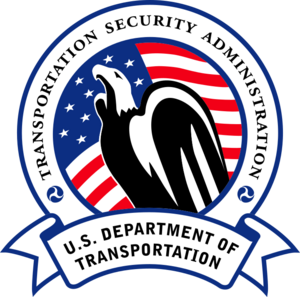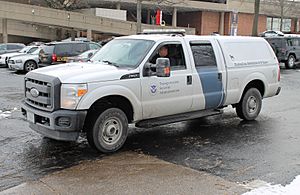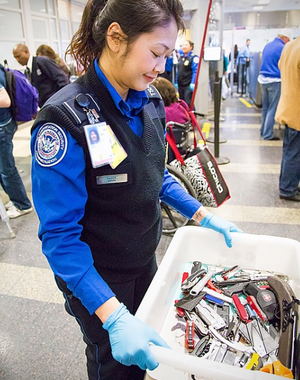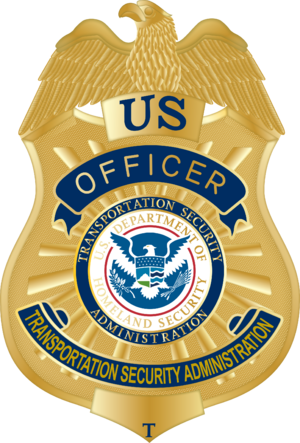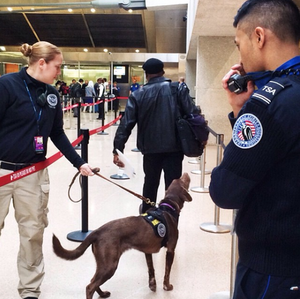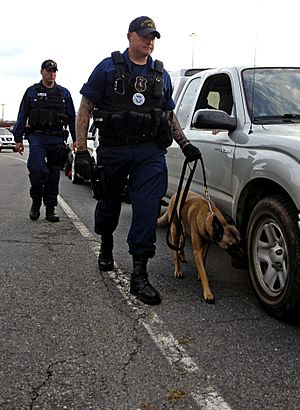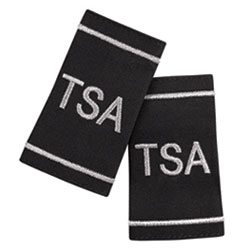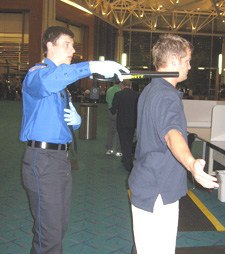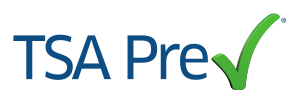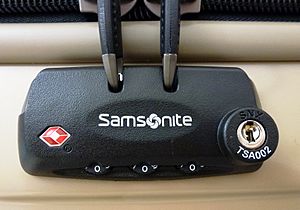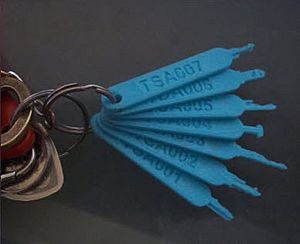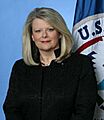Transportation Security Administration facts for kids
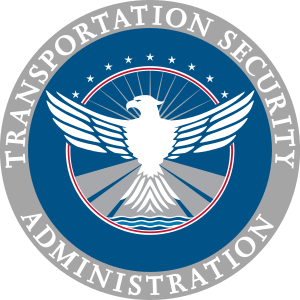
TSA seal
|
|

TSA wordmark
|
|
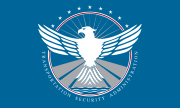 TSA flag |
|
| Agency overview | |
|---|---|
| Formed | November 19, 2001 |
| Preceding agency |
|
| Jurisdiction | Transportation systems inside, and connecting to, the United States of America |
| Headquarters | Springfield, Fairfax County, Virginia U.S. |
| Employees | 54,200+ (FY 2020) |
| Annual budget | $9.70 billion (FY 2023) |
| Agency executives |
|
| Parent department | Department of Homeland Security |
The Transportation Security Administration (TSA) is a government agency in the United States. It is part of the United States Department of Homeland Security (DHS). The TSA is in charge of keeping all transportation systems in and connected to the U.S. safe.
It was created after the September 11 attacks in 2001. Its main goal was to make airport security much better. It also brought all air travel security under one federal agency.
The TSA creates rules to protect many types of transportation. This includes highways, railroads, bus systems, public transit, ports, and pipelines. They work with other government groups to do this.
However, the TSA's most important job is airport security. They work to stop plane hijackings. They check passengers and bags at over 450 U.S. airports. They have many different types of officers. These include screening officers, dog handlers, and bomb experts. They also have armed Federal Air Marshals on planes.
The TSA started as part of the United States Department of Transportation. In 2003, it moved to the Department of Homeland Security. Its main office is in Springfield, Virginia. In 2023, the TSA had a budget of about $9.70 billion. It employed over 47,000 security staff.
The TSA has special ways to check passengers and their bags. This includes checking IDs, pat-downs, and full-body scanners. They also check for explosives. Since it started, some people have questioned if all their methods work well.
Contents
Why the TSA Was Created
The TSA was created because of the September 11 attacks in 2001. These attacks showed that airport security needed to be stronger. Before the TSA, many different private companies handled airport security. They worked for individual airlines.
People like Transportation Secretary Norman Mineta believed one federal agency could do a better job. They thought a single agency would protect air travel best.
Congress agreed with this idea. President George W. Bush signed the Aviation and Transportation Security Act into law on November 19, 2001. This law created the TSA.
The agency first belonged to the United States Department of Transportation. But on March 9, 2003, it moved. It became part of the new United States Department of Homeland Security.
Hiring screeners for the new agency was a huge task. Between February and December 2002, 1.7 million people applied. About 55,000 screening jobs were filled. This was one of the biggest hiring efforts in U.S. history.
How the TSA is Organized
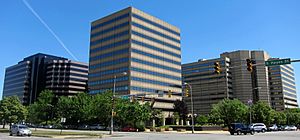
Who Leads the TSA
When the TSA was part of the Department of Transportation, its leader was called the Undersecretary. After moving to the United States Department of Homeland Security, the leader became the Administrator.
There have been seven Administrators and six acting Administrators. Many of them used to be Coast Guard officers.
In 2018, a new law set the Administrator's term to five years. It also made the Deputy Administrator a political appointment. The current Administrator is David Pekoske.
How the TSA is Structured
The Administrator leads the TSA. They are in charge of keeping airports, railways, and seaports safe. A Deputy Administrator helps the Administrator.
Many other leaders and experts also help run the agency. They work on different parts of the TSA's operations. This team works together to make sure transportation is secure.
The Executive Assistant Administrator for Law Enforcement also leads the Federal Air Marshal Service.
New Headquarters
In 2017, the TSA announced a new main office. It was built in Springfield, Virginia. The new building is very large. It cost $316 million to build. It is located near Fort Belvoir.
TSA Insignia
On September 11, 2018, the TSA got a new flag. It shows an American eagle in the center. The eagle's wings are spread out. This means protection and watchfulness.
The flag has nine stars and 11 rays. These refer to September 11. It also shows land and sea. This represents different ways of travel.
TSA Operations
Money and Budget
In 2020, the TSA's budget was about $7.68 billion.
| Budget | $ Million | Share |
|---|---|---|
| Operations and Support | 4,850 | 63% |
| Procurement, Construction, and Improvements | 110 | 1.4% |
| Research and Development | 23 | 0.3% |
| Not specified | 2,697 | 35% |
| Total | 7,680 | 100% |
Part of the TSA's money comes from a fee. This is a $5.60 fee for each one-way plane ticket. It is called the September 11 Security Fee. In 2020, this fee brought in $2.4 billion. This was about 32% of the budget.
The TSA also keeps loose change left by travelers. Since 2005, they have been allowed to keep this money. In 2018, they collected a record $960,105.49.
Airport Screening
Most airport screening in the U.S. is done by TSA officers. They are called Transportation Security Officers (TSOs). As of 2018, there were 46,661 TSOs.
TSOs check passengers and their bags. They also control entry and exit points at airports. They watch areas near checkpoints.
Some airports can choose to use private security companies. These companies must still follow TSA rules. Examples include San Francisco International Airport and Kansas City International Airport.
TSA Employees
Here are some types of TSA employees:
- Transportation Security Officers (TSOs): These officers screen people and property. They control entry points at airports. They use special equipment to find dangerous items. TSOs do not carry weapons. They cannot arrest people or use force.
- TSOs check bags and cargo. They look for dangerous objects.
- They perform searches, which can include pat-downs.
- They interact with the public and give directions.
- TSOs must stay focused in busy, noisy places. They need to make quick decisions.
- They must know all the rules and adapt to new situations.
- To become a TSO, you must be a U.S. Citizen. You must be at least 18 years old. You need to pass a medical exam and a background check.
- In 2019, TSO salaries ranged from about $28,668 to $40,954 per year.
- Behavior Detection Officers (BDOs): These are TSOs who watch passengers. They look for behaviors that might show a higher risk. If someone shows these behaviors, they might get extra screening.
- This program is called SPOT. It started in 2003.
- The TSA says BDOs only look at behavior, not a person's looks or background.
- Some groups have worried about this program. They say it might lead to unfair treatment.
- A government report in 2013 suggested cutting funds for SPOT. It said there was no proof it worked.
- Transportation Security Specialist – Explosives (TSS-Es): These are experts in explosives. They train other TSA employees. They help when regular checks cannot solve an alarm. They also work with police and bomb squads.
- These specialists must have military or FBI training in bomb disposal.
- Federal Air Marshals (FAMs): FAMs are law enforcement officers. They work undercover on planes. Their job is to protect air travel from attacks. FAMs carry weapons.
- The idea of "sky marshals" started in 1961.
- The Federal Air Marshal Service became part of the TSA after 9/11.
- In 2018, news came out about a secret program called "Quiet Skies." Marshals watched passenger behaviors on planes. This raised concerns about privacy.
- Federal Flight Deck Officers (FFDOs): These are airline pilots. They are trained and allowed to carry a firearm. They can use force to protect the cockpit. They work with FAMs to stop hijackings.
- This program is for pilots of U.S. airlines. It is voluntary.
- FFDOs are trained by the Federal Air Marshal Service.
- Transportation Security Inspectors (TSIs): TSIs check and investigate transportation systems. They make sure they are secure. This includes aviation, cargo, and surface transport.
- They also work internationally. They check foreign airports and airlines.
- National Explosives Detection Canine Team Program: This program trains dogs and their handlers. These teams can quickly find dangerous materials. In 2008, about 430 canine teams were trained. They work at airports and transit systems.
- Visible Intermodal Prevention and Response (VIPR) teams: VIPR teams started in 2005. They work outside of airports. They can be found at train stations, ports, or special events.
- Some people have criticized these teams. They worry about their actions.
TSA Uniforms
In 2008, TSA officers started wearing new uniforms. They have a royal blue shirt and dark blue pants. All TSOs began wearing the new uniform on September 11, 2008.
Officers get badges and shoulder boards after training. This training includes a 3-week academy.
COVID-19 Pandemic
The TSA continued to work during the COVID-19 pandemic in the United States. By the end of 2020, almost 5,000 TSA federal employees had tested positive for COVID-19. Sadly, 12 employees died from the virus.
Screening Rules and Procedures
Passenger and Carry-on Screening
ID Requirements
The TSA requires passengers aged 18 and older to show a valid ID. This happens at the security checkpoint. Valid IDs include U.S. passports, state IDs, or military IDs. If you do not have an ID, you might still fly. Your identity must be checked in other ways.
The Real ID Act was passed in 2005. It set security standards for state IDs. Federal agencies like the TSA can only accept IDs from states that meet these rules.
Acceptable IDs
Here are some IDs the TSA accepts:
- Driver's licenses from U.S. states.
- Tribal photo IDs.
- Canadian driver's licenses.
- Passports from other countries.
- Airline employee IDs.
- Federal employee IDs.
- U.S. passport and passport card.
- Trusted traveler cards (like Global Entry).
- Green cards (permanent resident cards).
- Military IDs.
- Veteran Health Identification Cards.
Passenger names are checked against the No Fly List. This list has names of people not allowed to fly. Names are also checked against a "selectee" list. People on this list get extra screening. Some people have criticized these lists for errors.
At the checkpoint, passengers are checked for banned items. These include sharp objects, weapons, and flammable liquids. Liquids and gels are limited to 3.4 ounces (100 ml). They must be in a clear, one-quart bag. These rules started after a bomb plot in 2006.
More firearms have been found in carry-on bags recently. The number has increased every year since 2008. In 2018, 4,239 firearms were found. Firearms can be checked in luggage on domestic flights.
Some government leaders and military officials can bypass security screening.
TSA PreCheck
The TSA PreCheck program started in 2011. It allows some travelers to get faster screening. This includes members of certain airline programs and the U.S. military.
To join, travelers complete a background check. They also get fingerprinted and pay a fee. Then they get a Known Traveler Number. This program is available at over 200 airports.
In 2013, the TSA started checking many databases for passenger information. This happens before passengers arrive at the airport. They can access travel history and other public records.
Printer Cartridge Ban
After a bomb plot in 2010, the U.S. banned large printer cartridges. Passengers cannot carry toner or ink cartridges over 16 ounces (453 grams). This applies to both carry-on and checked bags. It does not affect most regular travelers.
Enhanced Screening Procedures
In November 2010, the TSA added new screening steps. Passengers must choose between a patdown or a full body scanner. These changes were made after a bombing attempt.
Pat-downs
New pat-down rules were controversial. Some groups said they might violate privacy rights. Several lawsuits were filed.
Full Body Scanners
The TSA uses two types of full body scanners. They are called Advanced Imaging Technologies (AIT). Older scanners used X-rays. Newer ones use millimeter waves.
Operators no longer see images of the actual passenger. Instead, they see a stick figure. Yellow boxes show areas that need more checks. If the machine finds something, a pat-down is required.
In 2022, the TSA changed scanner rules. Passengers can now choose their gender marker. The machines' algorithms were updated to be fair to all people.
Full-body scanners have also caused privacy and health concerns. The TSA stopped using X-ray scanners that showed actual images. They now use only millimeter-wave machines. These machines use different technology.
Some people worry about radiation from X-ray scanners. However, the millimeter-wave scanners use non-ionizing radiation. This type of radiation is not known to harm DNA.
Reverse Screenings
In 2016, the TSA allowed "reverse screening" at small airports. Passengers are not screened before their flight. Instead, they are screened when they arrive at their destination. This can save money for airports with few flights.
Reactions to Screening
Some groups have raised concerns about the new screening methods. Pilots, for example, worried about radiation risks. They also wanted clear rules for pat-downs.
A group called EPIC filed a lawsuit in 2010. They wanted to stop the use of full-body scanners. They argued that the TSA did not follow proper procedures. In 2011, a court agreed. The TSA was told to get public comments on the rules.
Internet campaigns have also promoted "National Opt-Out Day." On this day, travelers were asked to choose a pat-down instead of a scanner.
Electronic Device Rules
In March 2017, the TSA banned large electronic devices. These devices were not allowed in carry-on bags on flights from 10 airports. These airports were in Muslim-majority countries. The rule was put in place due to terror threats. The restrictions ended in July after security changes at those airports.
Checked Baggage
The TSA can open checked bags to search them. If they cannot open a lock, they might cut it off. The TSA allows special locks that they can open with a master key. These are made by companies like Travel Sentry.
However, TSA agents sometimes still cut these locks. In 2011, over 3,500 complaints were made about locks being damaged. Some experts say these special locks are not very secure.
In 2014, a photo of TSA master keys was accidentally published. This allowed people to create copies of the keys using 3D printing. This raised concerns about how secure these locks really are.
Non-Airport Rules
While known for airports, the TSA also makes rules for other transportation. This includes systems without passengers. For example, the TSA set up cybersecurity rules after a pipeline attack in 2021. They now have new rules for oil and gas companies.
Images for kids
See also
 In Spanish: Administración de Seguridad en el Transporte para niños
In Spanish: Administración de Seguridad en el Transporte para niños
- Airline complaints
- Border Force
- Canadian Air Transport Security Authority
- International Civil Aviation Organization
- Lost luggage
- Okoban


